诗歌的韵律及押韵格式
诗歌的韵律及押韵格式
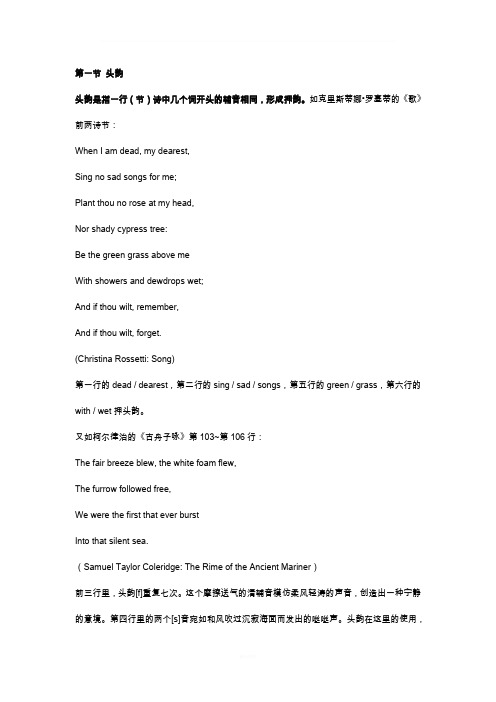
第一节头韵头韵是指一行(节)诗中几个词开头的辅音相同,形成押韵。
如克里斯蒂娜•罗塞蒂的《歌》前两诗节:When I am dead, my dearest,Sing no sad songs for me;Plant thou no rose at my head,Nor shady cypress tree:Be the green grass above meWith showers and dewdrops wet;And if thou wilt, remember,And if thou wilt, forget.(Christina Rossetti: Song)第一行的dead / dearest,第二行的sing / sad / songs,第五行的green / grass,第六行的with / wet押头韵。
又如柯尔律治的《古舟子咏》第103~第106行:The fair breeze blew, the white foam flew,The furrow followed free,We were the first that ever burstInto that silent sea.(Samuel Taylor Coleridge: The Rime of the Ancient Mariner)前三行里,头韵[f]重复七次。
这个摩擦送气的清辅音模仿柔风轻涛的声音,创造出一种宁静的意境。
第四行里的两个[s]音宛如和风吹过沉寂海面而发出的咝咝声。
头韵在这里的使用,令读者有身临其境之感。
另外,中间韵blew / flew,first / burst,furrow / followed,尾韵free / sea形成悦耳动听的韵味和节奏感。
再如莎士比亚编号为71的十四行诗前八行:No longer mourn for me when I am deadThan you shall hear the surly sullen bellGive warning to the world that I am fledFrom this vile world with vilest worms to dwell.Nay, if you read this line, remember notThe hand that writ it; for I love you soThat I in your sweet thoughts would be forgotIf thinking on me would make you woe.每行都有不同的头韵。
五律平仄韵律格式
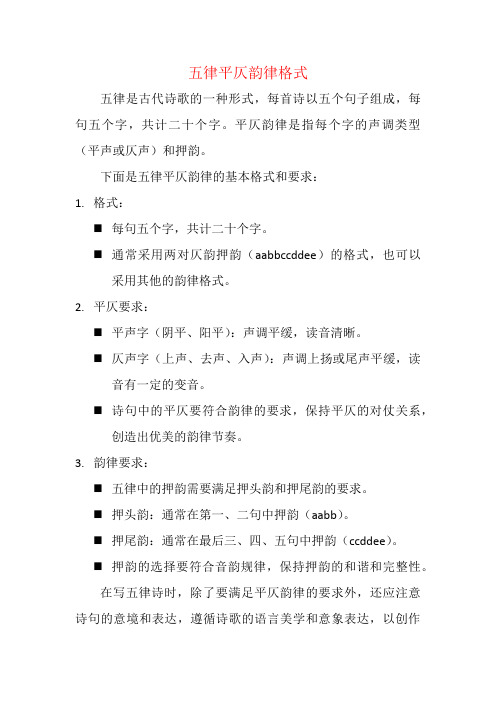
五律平仄韵律格式
五律是古代诗歌的一种形式,每首诗以五个句子组成,每句五个字,共计二十个字。
平仄韵律是指每个字的声调类型(平声或仄声)和押韵。
下面是五律平仄韵律的基本格式和要求:
1.格式:
⏹每句五个字,共计二十个字。
⏹通常采用两对仄韵押韵(aabbccddee)的格式,也可以
采用其他的韵律格式。
2.平仄要求:
⏹平声字(阴平、阳平):声调平缓,读音清晰。
⏹仄声字(上声、去声、入声):声调上扬或尾声平缓,读
音有一定的变音。
⏹诗句中的平仄要符合韵律的要求,保持平仄的对仗关系,
创造出优美的韵律节奏。
3.韵律要求:
⏹五律中的押韵需要满足押头韵和押尾韵的要求。
⏹押头韵:通常在第一、二句中押韵(aabb)。
⏹押尾韵:通常在最后三、四、五句中押韵(ccddee)。
⏹押韵的选择要符合音韵规律,保持押韵的和谐和完整性。
在写五律诗时,除了要满足平仄韵律的要求外,还应注意诗句的意境和表达,遵循诗歌的语言美学和意象表达,以创作
出优美和具有艺术感的诗篇。
五律平仄韵律格式的要求可能因具体的文学作品和时代的变迁而有所差异。
语文诗歌的韵律和格律

语文诗歌的韵律和格律语文诗歌作为一种独特的文学形式,具有丰富的韵律和格律,它们是诗歌美感的重要组成部分。
本文将探讨语文诗歌的韵律和格律,以及它们对诗歌表达和阅读的影响。
一、韵律的重要性韵律是诗歌的基本形式特征,它是通过对音节、音韵的巧妙运用实现的。
韵律可以增加诗歌的声韵美感,使诗歌变得优雅动人。
通过韵律的运用,诗人可以有效地表达情感,达到情感共鸣的效果。
同时,韵律也帮助读者更好地记忆和理解诗歌,增强诗歌的艺术感染力。
二、押韵的形式押韵是指诗歌中同一行或不同行的末尾音节或音韵相同或相似的现象。
常见的押韵形式有平仄押韵、单韵押韵、双韵押韵等。
例如在“登鹳雀楼”中,“白日依山尽,黄河入海流”中的“尽”和“流”就构成了平仄押韵;在“千山鸟飞绝,万径人踪灭”中,每一句的“绝”和“灭”形成了单韵押韵。
三、格律的多样性格律是指诗歌在结构上的规定,它包括诗歌的句子结构、节奏、韵律和长度等方面的要求。
不同的诗体和格律有着不同的特点和要求。
例如,古体诗使用四言、五言、七言等固定的字数和格律,如《古朗月行》的五言绝句;现代诗则更加灵活多样,不拘泥于传统的格律,如自由诗、白话诗等。
四、韵律和格律对诗歌表达的影响韵律和格律对诗歌的表达具有重要影响。
首先,韵律和格律的运用可以使诗歌的节奏感更明显,增加诗歌的音乐感和韵律美。
其次,韵律和格律有助于诗歌情感的表达。
通过合适的押韵和格律,诗人可以更好地表达自己的情感,创造出具有感染力的诗歌作品。
最后,韵律和格律对诗歌的阅读体验至关重要。
读者在阅读诗歌时,往往会受到韵律和格律的引导,更加享受诗歌的美感和韵律。
综上所述,语文诗歌的韵律和格律是诗歌美感的重要组成部分。
它们通过押韵、格律等形式的运用,丰富了诗歌的艺术性和感染力,使诗歌成为一种独特的文学形式。
诗歌的韵律和格律对于诗歌的表达和阅读都具有重要的影响,它们是诗歌美学研究的重要内容,也是我们欣赏诗歌作品的重要角度之一。
诗词的韵律与押韵技巧
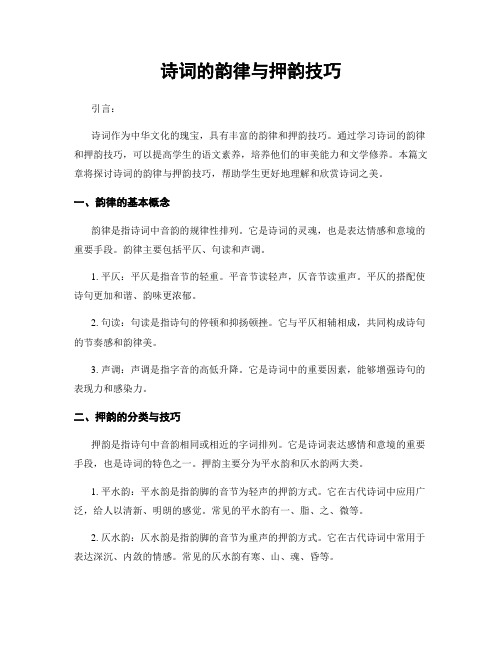
诗词的韵律与押韵技巧引言:诗词作为中华文化的瑰宝,具有丰富的韵律和押韵技巧。
通过学习诗词的韵律和押韵技巧,可以提高学生的语文素养,培养他们的审美能力和文学修养。
本篇文章将探讨诗词的韵律与押韵技巧,帮助学生更好地理解和欣赏诗词之美。
一、韵律的基本概念韵律是指诗词中音韵的规律性排列。
它是诗词的灵魂,也是表达情感和意境的重要手段。
韵律主要包括平仄、句读和声调。
1. 平仄:平仄是指音节的轻重。
平音节读轻声,仄音节读重声。
平仄的搭配使诗句更加和谐、韵味更浓郁。
2. 句读:句读是指诗句的停顿和抑扬顿挫。
它与平仄相辅相成,共同构成诗句的节奏感和韵律美。
3. 声调:声调是指字音的高低升降。
它是诗词中的重要因素,能够增强诗句的表现力和感染力。
二、押韵的分类与技巧押韵是指诗句中音韵相同或相近的字词排列。
它是诗词表达感情和意境的重要手段,也是诗词的特色之一。
押韵主要分为平水韵和仄水韵两大类。
1. 平水韵:平水韵是指韵脚的音节为轻声的押韵方式。
它在古代诗词中应用广泛,给人以清新、明朗的感觉。
常见的平水韵有一、脂、之、微等。
2. 仄水韵:仄水韵是指韵脚的音节为重声的押韵方式。
它在古代诗词中常用于表达深沉、内敛的情感。
常见的仄水韵有寒、山、魂、昏等。
押韵的技巧主要包括韵脚的选择和韵尾的变化。
1. 韵脚的选择:韵脚的选择要根据整个诗句的平仄和意境来确定。
一般来说,平水韵适合表达轻快、明快的情感,而仄水韵适合表达深沉、内敛的情感。
2. 韵尾的变化:韵尾的变化可以增加诗句的变化和层次感。
通过改变韵尾的音韵,可以使押韵更加丰富多样,给人以更深刻的印象。
三、韵律与押韵在诗词中的应用韵律和押韵在诗词中起着至关重要的作用。
它们能够使诗词更加动听、优美,增强诗词的表现力和感染力。
1. 韵律的应用:韵律通过平仄、句读和声调的运用,使诗句节奏感强烈,音韵和谐。
学生可以通过朗读诗句,感受其中的韵律美,提高自己的语感和表达能力。
2. 押韵的应用:押韵通过音韵的相同或相近,使诗句更加鲜活、生动。
诗歌的平仄押韵规则
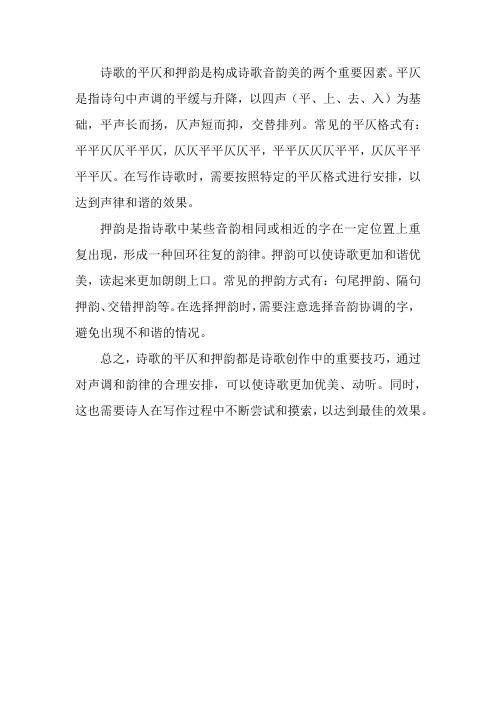
诗歌的平仄和押韵是构成诗歌音韵美的两个重要因素。
平仄是指诗句中声调的平缓与升降,以四声(平、上、去、入)为基础,平声长而扬,仄声短而抑,交替排列。
常见的平仄格式有:平平仄仄平平仄,仄仄平平仄仄平,平平仄仄仄平平,仄仄平平平平仄。
在写作诗歌时,需要按照特定的平仄格式进行安排,以达到声律和谐的效果。
押韵是指诗歌中某些音韵相同或相近的字在一定位置上重复出现,形成一种回环往复的韵律。
押韵可以使诗歌更加和谐优美,读起来更加朗朗上口。
常见的押韵方式有:句尾押韵、隔句押韵、交错押韵等。
在选择押韵时,需要注意选择音韵协调的字,避免出现不和谐的情况。
总之,诗歌的平仄和押韵都是诗歌创作中的重要技巧,通过对声调和韵律的合理安排,可以使诗歌更加优美、动听。
同时,这也需要诗人在写作过程中不断尝试和摸索,以达到最佳的效果。
诗歌的韵律和表达

诗歌的韵律和表达一、诗歌的韵律1.韵律的定义:诗歌中的韵律是指诗的音节、重音、停顿和节奏等方面的组织形式。
2.韵律的分类:(1)古体诗的韵律:以五言、七言为主,讲究平仄、对仗和押韵。
(2)近体诗的韵律:以律诗、绝句为主,有严格的平仄、对仗和押韵要求。
(3)现代诗的韵律:形式多样,不受平仄、对仗限制,注重自由发挥。
3.押韵:诗歌中相同或相近韵母的音节在句子末尾相押,形成美感。
4.平仄:古代诗歌的音调分类,平声和仄声的搭配。
平声柔和,仄声刚劲。
5.对仗:诗歌中词与词、句与句之间在字数、词性、意义等方面的呼应和对应。
二、诗歌的表达1.意象:诗歌中用来寄托诗人情感的物象,具有象征意义。
2.意境:诗歌中所创造的具有情感色彩的艺术空间,体现了诗人的思想感情。
3.修辞手法:(1)比喻:用一个事物来描绘另一个事物,增强表现力。
(2)拟人:赋予非人类事物以人的情感和行为,增强生动性。
(3)夸张:对事物进行夸大处理,突出其特点。
(4)排比:句子结构相同或相似,语气一致,增强语势。
4.抒情方式:(1)直接抒情:诗人直接表达自己的情感。
(2)间接抒情:通过描绘景物、叙述事件来间接表达情感。
5.表现手法:(1)渲染:通过反复描绘,使事物形象更加鲜明。
(2)对比:将两个相反或相对的事物放在一起,突出其特点。
(3)象征:用具体事物代表抽象概念,增强表现力。
6.结构布局:诗歌的开头、结尾、过渡和照应等部分的组织安排。
综上所述,诗歌的韵律和表达是诗歌创作中非常重要的两个方面。
掌握韵律规律和表达技巧,有助于创作出具有美感和表现力的诗歌作品。
习题及方法:1.习题:请判断以下诗句中哪个字的韵脚押韵?诗句:“床前明月光,疑是地上霜。
”解题方法:首先,找出诗句中的韵脚,即“光”和“霜”。
然后,判断两个字的韵母是否相同或相近。
在本题中,“光”和“霜”的韵母都是“ang”,因此它们押韵。
2.习题:请判断以下诗句中哪个字的平仄是正确的?诗句:“白日依山尽,黄河入海流。
现代诗歌押韵规则

现代诗歌押韵规则一、什么是押韵。
在现代诗歌里,押韵简单来说就是让诗句的最后一个字的韵母相同或者相近。
比如说“天上的云儿白又白(bái),地上的花儿开不败(bài)”,这里的“白”和“败”的韵母“ai”相同,这就形成了押韵。
这就像是给诗歌穿上了一双搭配协调的鞋子,让诗句读起来有一种和谐的节奏感,就像音乐里的鼓点一样,一下一下地敲在读者的心坎上。
二、单押。
1. 解析。
- 单押是现代诗歌押韵中最常见的一种形式。
就是每一行的最后一个字押韵。
例如:“我在黑夜中徘徊(huái),寻找心中的那片海(hǎi)。
”这里“徊”和“海”押韵,都是押“ai”这个韵。
这种押韵方式简单直接,就像走直线一样,能够很清晰地让读者感受到诗歌的韵律之美。
它就像是一个简洁的节奏大师,用一种单纯的方式带动诗歌的节奏。
2. 举例。
三、双押。
1. 解析。
- 双押呢,就是相连的两个字或者两个词的最后一个字押韵。
这就好比是给诗歌的韵律来了个“双重奏”。
比如说“快乐(lè)的小伙(huǒ),心中有团火(hu ǒ)。
”这里“快乐”的“乐”和“小伙”的“伙”就形成了双押。
双押比单押更有节奏感,像是在诗歌的跑道上加速跑了起来,能让诗歌的韵律更加紧凑和强烈,读起来就更带感,就像说唱音乐里那种很有冲击力的节奏一样。
2. 举例。
- 在一些现代的说唱诗歌或者有强烈节奏感的现代诗中经常会用到双押。
例如:“城市(shì)的故事(shì),写满了人世(shì)的得失(shī)。
”这里“城市”和“故事”、“人世”和“得失”分别形成双押,让诗句充满了一种独特的韵律张力。
四、隔行押。
1. 解析。
- 隔行押就是每隔一行押一次韵。
这种押韵方式就像是在跳格子,不是每一步都踩在相同的节奏点上,但又有规律可循。
它给诗歌带来一种错落有致的韵律感。
就好像是两个人交替着敲鼓,你敲一下,我敲一下,配合得很巧妙。
这样的押韵方式可以让诗歌在韵律和表达内容上有更多的灵活性,不会因为一直押韵而显得过于呆板。
【诗词格律与写作】韵、韵脚、韵书、押韵

【诗词格律与写作】韵、韵脚、韵书、押韵参考教材❆王力《诗词格律》❆龙榆生《唐宋词格律》❆施东向《诗词格律初阶》❆《声律启蒙》一、韵:韵包括:韵头韵腹韵尾以“光”为例Guan g 光G作为声母在押韵上面完全不考虑;u为韵头,部分简单的韵没有韵头;an为韵腹,有韵就一定有韵腹;g为韵尾,部分简单的韵没有韵尾;注意:不是每一个韵都有韵头和韵尾二、韵脚:以登鹳雀楼为例:白日依山尽黄河入海流(liu)欲穷千里目更上一层楼(lou)这里的流和楼就是韵脚,在诗里需要押韵的句子中最末一个字叫韵脚;我们可以看到“流l i u”和“楼l o u”韵头并不相同,但是韵腹部分是完全相同的,这两个韵都没有韵尾。
三、韵书:王力先生有一句著名的话:唐以前的人按口语押韵;唐以后的人按韵书押韵。
从唐朝开始,为满足科举考试需要,制定了有统一押韵标准的韵书,所以唐代及之后的人都按照韵书押韵。
隋陆法言《切韵》成于隋仁寿元年(601年)目前只剩残篇没有完书;《切韵》是有记载的最早的韵书,作为韵书史上划时代的产物,它继承和总结了前代韵书,是这一系列韵书的定型之作,在汉语语音史上有很重要的地位。
共收193韵:平声54韵,上声51韵,去声56韵,入声32韵,收字11500字;《切韵》以当时的读书音为基础,兼顾古音、方言编辑成书,所描写的不是某时某地的一个单纯音系,而是该时期语音的综合反映。
“时俗共重,以为典规。
然苦字少,复阙字义”(王仁昫xu 评价此书不足,一个是收字太少,二是没有解释)。
唐孙愐《唐韵》成于唐天宝年间、开元年间;“今加三千五百字,通旧总一万五千文,其注训解不在次数”共收195韵:平声上26韵,平声下28韵;上声52韵,去声57韵;入声32韵;《唐韵》注意正字形,还增加了不少注解;宋陈彭年、邱雍(广韵)成于宋大中祥符元年(1008)全名为《大宋重修广韵》《广韵》对后世的影响巨大,没有任何一本韵书能超过他的影响;共收206韵:上平28韵,下平29韵,上声55韵,去声60韵,入声34韵,收字26194,注解191692字;《广韵》收录了许多奇怪冷僻的字,之后40余年,又出了《集韵》收字53525(比《广韵》多27331字)。
了解诗歌中的韵律和押韵规律
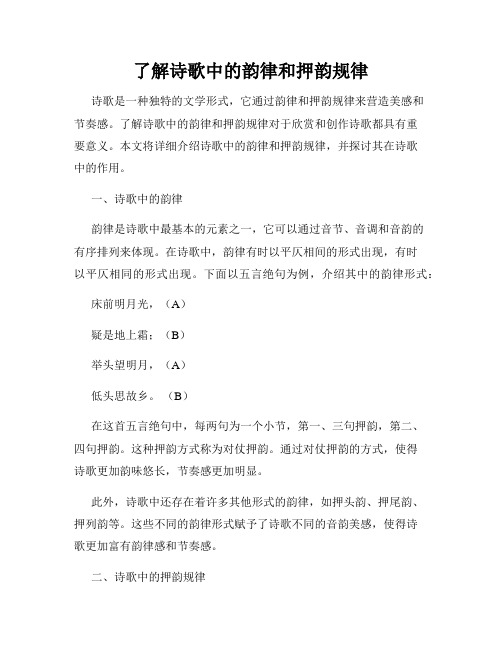
了解诗歌中的韵律和押韵规律诗歌是一种独特的文学形式,它通过韵律和押韵规律来营造美感和节奏感。
了解诗歌中的韵律和押韵规律对于欣赏和创作诗歌都具有重要意义。
本文将详细介绍诗歌中的韵律和押韵规律,并探讨其在诗歌中的作用。
一、诗歌中的韵律韵律是诗歌中最基本的元素之一,它可以通过音节、音调和音韵的有序排列来体现。
在诗歌中,韵律有时以平仄相间的形式出现,有时以平仄相同的形式出现。
下面以五言绝句为例,介绍其中的韵律形式:床前明月光,(A)疑是地上霜;(B)举头望明月,(A)低头思故乡。
(B)在这首五言绝句中,每两句为一个小节,第一、三句押韵,第二、四句押韵。
这种押韵方式称为对仗押韵。
通过对仗押韵的方式,使得诗歌更加韵味悠长,节奏感更加明显。
此外,诗歌中还存在着许多其他形式的韵律,如押头韵、押尾韵、押列韵等。
这些不同的韵律形式赋予了诗歌不同的音韵美感,使得诗歌更加富有韵律感和节奏感。
二、诗歌中的押韵规律押韵是指诗歌中的音韵重复现象,通过相同或相似的音韵组合来增加诗歌的美感。
押韵可以是词尾韵(如“花”、“车”)、词首韵(如“明”、“朦”)以及词中韵(如“秋千”、“蓦然”)等。
在汉语中,诗歌的押韵有严格的规律。
一般来说,五言绝句、七言绝句等具有固定的押韵规律。
以五言绝句为例:A(平)A(平)B(仄)B(仄)A(平)C(平)C(平)D(仄)D(仄)C(平)在这里,A、B、C、D代表不同的韵脚。
根据这种押韵规律,形成了许多经典的诗句,如“白日依山尽,黄河入海流”,其中“尽”与“流”押平声,而“白”、“日”、“依””山”押仄声。
押韵不仅可以增加诗歌的音韵美感,还可以使诗歌更加易于记忆。
通过押韵的方式,诗歌可以更加流畅地传达作者的情感和思想。
三、韵律和押韵对诗歌的作用韵律和押韵是诗歌中的重要元素,对于诗歌的整体美感起着不可忽视的作用。
首先,韵律和押韵使得诗歌更加有节奏感和音韵美感,让人能够更加享受诗歌带来的美的享受。
其次,韵律和押韵增加了诗歌的记忆性。
古诗词的韵律和押韵

古诗词的韵律和押韵古诗词是中国传统文化的瑰宝,它以其独特的韵律和押韵形式,给人们带来了深深的艺术享受。
本文将从古诗词的韵律和押韵两个方面展开讨论,为读者揭示这些音韵之美的奥秘。
一、古诗词的韵律古诗词的韵律是指诗句中音节的组织和排列方式。
它可以分为平仄、轻重和抑扬格三个层面。
首先是平仄。
古代汉语有平声、仄声之分,平仄声的使用决定了古诗词的韵律。
在平声字中,声调先升后降;而仄声字则声调先降后升。
通过平仄的运用,古诗词的音节可以达到谐美之效。
其次是轻重。
轻重是指每个音节的重音和轻音之分。
重音音节在发声时重压,轻音音节则较轻。
轻重的运用可以调整语调的韵律感,增强整首古诗词的节奏感。
最后是抑扬格。
抑扬格是指字句中音韵高低的起伏。
古诗词常常使用抑扬格来表现情感的抑扬顿挫,使作品更加生动有力。
通过平仄、轻重和抑扬格的运用,古诗词形成了独特的韵律美,使得读者在朗读或欣赏时能够感受到抑扬顿挫的魅力。
二、古诗词的押韵古诗词的押韵是指诗句中音韵相同或相近的字词排列。
它可以分为押平韵和押仄韵两个类型。
押平韵是指在诗句中押平声字,使得音韵和谐。
例如唐代杜牧的《秋夜将晓出篱门迎凉有感二首·其一》:“银烛秋光冷画屏,轻罗小扇扑流萤。
天阶夜色凉如水,卧看牵牛织女星。
”诗中的“屏”和“萤”、“水”和“星”都是平声字,通过押平韵的运用,使得诗句更加和谐。
押仄韵是指在诗句中押仄声字,使得音韵相近。
例如唐代杜甫的《月夜忆舍弟》:“戍鼓断人行,边秋一雁声。
露从今夜白,月是故乡明。
”诗中的“行”和“声”、“白”和“明”都是仄声字,押仄韵的运用增强了整首诗的音乐感。
通过押韵的方式,古诗词形成了优美的音韵,并给人们带来了愉悦的感受。
押韵除了使诗歌更具韵律美外,还有助于人们记忆和传播古诗词。
综上所述,古诗词的韵律和押韵是其独特之处。
通过运用平仄、轻重、抑扬格以及押平韵和押仄韵等手法,古代文人通过抒发思想情感,创作了一首首优美动人的古诗词作品。
古代诗歌的韵律与韵脚
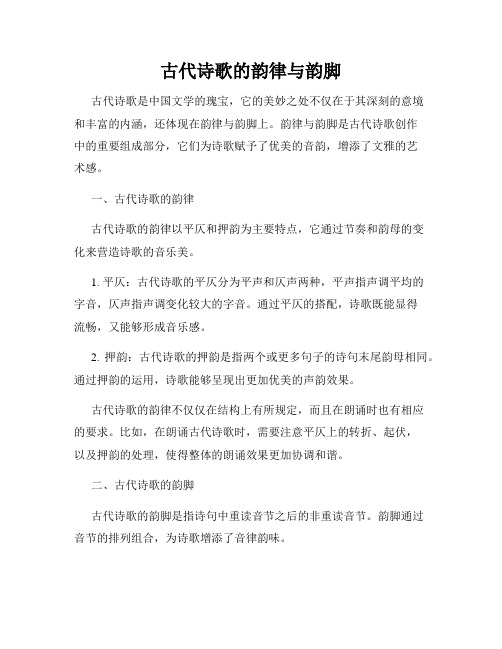
古代诗歌的韵律与韵脚古代诗歌是中国文学的瑰宝,它的美妙之处不仅在于其深刻的意境和丰富的内涵,还体现在韵律与韵脚上。
韵律与韵脚是古代诗歌创作中的重要组成部分,它们为诗歌赋予了优美的音韵,增添了文雅的艺术感。
一、古代诗歌的韵律古代诗歌的韵律以平仄和押韵为主要特点,它通过节奏和韵母的变化来营造诗歌的音乐美。
1. 平仄:古代诗歌的平仄分为平声和仄声两种,平声指声调平均的字音,仄声指声调变化较大的字音。
通过平仄的搭配,诗歌既能显得流畅,又能够形成音乐感。
2. 押韵:古代诗歌的押韵是指两个或更多句子的诗句末尾韵母相同。
通过押韵的运用,诗歌能够呈现出更加优美的声韵效果。
古代诗歌的韵律不仅仅在结构上有所规定,而且在朗诵时也有相应的要求。
比如,在朗诵古代诗歌时,需要注意平仄上的转折、起伏,以及押韵的处理,使得整体的朗诵效果更加协调和谐。
二、古代诗歌的韵脚古代诗歌的韵脚是指诗句中重读音节之后的非重读音节。
韵脚通过音节的排列组合,为诗歌增添了音律韵味。
1. 七绝韵脚:七绝是指每一句有七个字的诗,它的韵脚有平声韵、仄声韵以及双声韵等。
比如,“明月别枝惊鹊,清风半夜鸣蝉”。
2. 五言绝句韵脚:五言绝句是指每一句有五个字的诗,其韵脚可以有仄声韵和双声韵等。
比如,“白日依山尽,黄河入海流”。
古代诗歌的韵脚不仅有规定的格式,而且在创作中还要注重音韵的变化和谐调。
诗人通过巧妙地运用不同的韵脚,能够使诗歌更加优美、动人。
三、古代诗歌的意义与价值古代诗歌的韵律与韵脚并非只是为了追求技巧和艺术,它们更深层次地体现了中国文化的独特魅力和审美趣味。
首先,古代诗歌的韵律与韵脚能够增强诗歌的表现力和感染力。
通过平仄的变化和押韵的运用,诗歌能够更好地表现情感、描绘景物,使读者在阅读时能够更加深入地感受到诗人的情感与意境。
其次,古代诗歌的韵律与韵脚也反映了文人士人追求音响美的特点。
古代文人士人崇尚音乐美,他们通过诗歌的创作来表达自己的情感,追求美的体验和审美愉悦。
怎样确定诗歌的韵脚?
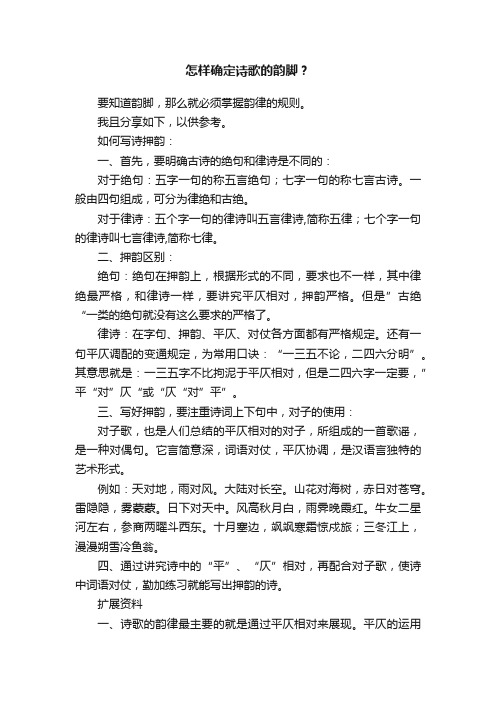
怎样确定诗歌的韵脚?要知道韵脚,那么就必须掌握韵律的规则。
我且分享如下,以供参考。
如何写诗押韵:一、首先,要明确古诗的绝句和律诗是不同的:对于绝句:五字一句的称五言绝句;七字一句的称七言古诗。
一般由四句组成,可分为律绝和古绝。
对于律诗:五个字一句的律诗叫五言律诗,简称五律;七个字一句的律诗叫七言律诗,简称七律。
二、押韵区别:绝句:绝句在押韵上,根据形式的不同,要求也不一样,其中律绝最严格,和律诗一样,要讲究平仄相对,押韵严格。
但是”古绝“一类的绝句就没有这么要求的严格了。
律诗:在字句、押韵、平仄、对仗各方面都有严格规定。
还有一句平仄调配的变通规定,为常用口诀:“一三五不论,二四六分明”。
其意思就是:一三五字不比拘泥于平仄相对,但是二四六字一定要,”平“对”仄“或“仄“对”平”。
三、写好押韵,要注重诗词上下句中,对子的使用:对子歌,也是人们总结的平仄相对的对子,所组成的一首歌谣,是一种对偶句。
它言简意深,词语对仗,平仄协调,是汉语言独特的艺术形式。
例如:天对地,雨对风。
大陆对长空。
山花对海树,赤日对苍穹。
雷隐隐,雾蒙蒙。
日下对天中。
风高秋月白,雨霁晚霞红。
牛女二星河左右,参商两曜斗西东。
十月塞边,飒飒寒霜惊戍旅;三冬江上,漫漫朔雪冷鱼翁。
四、通过讲究诗中的“平”、“仄”相对,再配合对子歌,使诗中词语对仗,勤加练习就能写出押韵的诗。
扩展资料一、诗歌的韵律最主要的就是通过平仄相对来展现。
平仄的运用也有一定格式,称为格律。
平声和仄声,代指由平仄构成的诗文的韵律。
现代对于平仄的区分主要通过汉语拼音,将一二声作为平,三四声作为仄。
在古代,明朝释真空的《玉钥匙歌诀》曰:平声平道莫低昂,上声高呼猛烈强,去声分明哀远道,入声短促急收藏。
简单来说,区别平仄的要诀就是“不平就是仄”。
二、对于不同长短和不同平仄开头的诗也有不同的规范;五律平起:首句第一第二字均为平声五律仄起:首句第一第二字均为仄声七律平起:首句第二字必用平声七律仄起:首句第二字必用仄声参考资料:百度百科——绝句,百度百科——律诗谢谢!。
古代诗词的韵律与格律

古代诗词的韵律与格律古代诗词是中国文学的瑰宝,其独特之处在于其韵律与格律的运用。
韵律与格律指的是诗句中的音韵模式和诗句结构,它们赋予了诗词以独特的节奏感和美感。
本文将探讨古代诗词的韵律与格律,并对其特点和影响进行分析。
一、古代诗词的韵律古代诗词的韵律是指诗句构成的音韵模式。
在古代,文人士大夫注重音韵的对仗和谐,通过韵律的运用来增添诗词的意境和美感。
首先,古代诗词的韵律分为平仄和押韵。
平仄是指诗句中音节的轻重,可分为平声和仄声。
平声指音节语音的轻音,仄声指音节语音的重音。
而押韵则是指诗句中音节的结尾音相同或近似,增强了整篇诗词的音韵效果。
其次,古代诗词的韵律还表现在句子的长短和节奏上。
一般来说,古代诗词倾向于使用单音节的平仄音节,以保持句子的短小精悍的特点。
同时,通过对诗句中的字词使用轻变音调或重变音调,可以形成不同的节奏感,进一步强化韵律效果。
古代诗词通过韵律的运用,使得整首诗词在音韵上呼应和谐,使得读者在品读时能够感受到一种韵律之美。
二、古代诗词的格律古代诗词的格律是指诗句的结构和排列方式。
格律规定了诗词的字数、句式和韵律要求,使得诗词具有一定的结构和形式。
首先,古代诗词的格律要求诗句的字数固定。
例如,五言绝句要求每句五个字,七言绝句要求每句七个字。
通过限制字数,使诗句简洁明了,增强诗歌的表达力。
其次,在格律方面,古代诗词分为四种基本格式:绝句、律诗、词、曲。
绝句是最为常见的格式,每句五、七个字,通常由四句构成。
律诗是七言绝句的扩展,每句七个字,并且要求每两句之间要呼应韵律。
词是以唱为主的格式,常用于歌曲中,每句七个字,短小精悍,常见于宋词。
曲则是指长篇的散曲,通常由多个词组成。
古代诗词的格律规定了诗句的结构和形式,使得诗词具有一定的规范性和美感。
读者在欣赏时,可以通过格律的呼应和谐感受到其中的韵律之美。
三、古代诗词韵律与格律的影响古代诗词的韵律与格律在中国文学史上产生了深远的影响。
首先,韵律和格律的运用使得古代诗词具有独特的美感和表现力,增强了诗词的艺术性和感染力,使其成为中国文化的重要组成部分。
诗词的平仄韵律常识
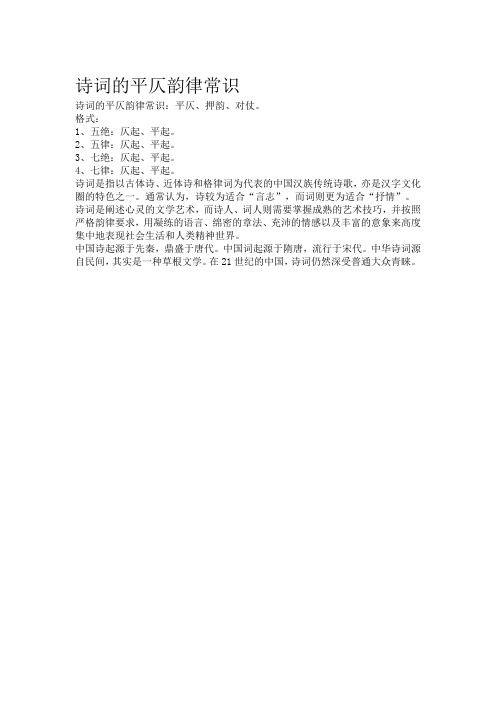
诗词的平仄韵律常识
诗词的平仄韵律常识:平仄、押韵、对仗。
格式:
1、五绝:仄起、平起。
2、五律:仄起、平起。
3、七绝:仄起、平起。
4、七律:仄起、平起。
诗词是指以古体诗、近体诗和格律词为代表的中国汉族传统诗歌,亦是汉字文化圈的特色之一。
通常认为,诗较为适合“言志”,而词则更为适合“抒情”。
诗词是阐述心灵的文学艺术,而诗人、词人则需要掌握成熟的艺术技巧,并按照严格韵律要求,用凝练的语言、绵密的章法、充沛的情感以及丰富的意象来高度集中地表现社会生活和人类精神世界。
中国诗起源于先秦,鼎盛于唐代。
中国词起源于隋唐,流行于宋代。
中华诗词源自民间,其实是一种草根文学。
在21世纪的中国,诗词仍然深受普通大众青睐。
7言律诗格式

7言律诗格式
七言律诗是我国传统诗歌形式之一,它的特点是每句诗有七个字,
并且音调属于平仄规律。
在写作七言律诗时,需要遵循一定的格式要求。
七言律诗的格式要求如下:
1. 字数:每句七个字,一首诗共四句,总共二十八个字。
2. 韵律:整首诗分为四个独立的句子,每句的第一、四个字必须平
声(平平平仄),第二、三个字可以为仄声(平声仄仄),也可以为
平声(平平平平)。
3. 押韵:每句的第一、四个字押韵,一般采用仄声押韵。
4. 词牌:七言律诗并没有特定的词牌,可以自由选取。
下面是一首按照七言律诗格式写就的诗:
白日依山尽,
黄河入海流。
欲穷千里目,
更上一层楼。
这首诗共四句,每句七个字,总共二十八个字。
其中,第一、四句
的第一个字“尽”和“楼”押韵。
第一句的音调为平平平仄,第二句的音调为平平仄平,第三句的音调为平平仄平仄,第四句的音调为平平平仄。
这首诗表达了人们不断追求进步的精神,不满足于现状,勇往直前,向更高的目标前进。
七言律诗的格式要求比较简明直观,但写作起来需要注意平仄音韵
的掌握,同时也要注重内容的表达。
通过七言律诗的艺术形式,可以
更好地展现诗人的思想情感,使读者在欣赏诗歌的同时,产生共鸣和
体验。
总之,七言律诗是一种古老的诗歌形式,在写作过程中需要严格按
照格式要求进行创作。
通过熟悉、理解并运用七言律诗的格式,我们
可以创作出优美动人、富有艺术感的诗歌作品。
如何运用押韵写好现代诗

如何运用押韵写好现代诗押韵是一种常见的写诗技巧,可以为现代诗增添韵律美感。
本文将探讨如何运用押韵写好现代诗,并给出一些实用的押韵技巧和示例。
一、押韵的定义与分类押韵是指诗歌中出现的音韵相同或相近的词语,可以给诗歌增加韵律美,提升节奏感。
押韵可分为纯押韵和近押韵两种形式。
1. 纯押韵:诗歌中相邻的两个或多个音节在辅音和韵母上完全相同,例如:“风花雪月”、“明日黄花”等。
2. 近押韵:诗歌中相邻的两个或多个音节的韵母相同或相近,例如:“山青水碧”、“春花秋月”等。
二、押韵的技巧与方法为了写好现代诗,我们可以运用以下一些押韵技巧:1. 内押韵:在同一句或同一行中,将两个或多个词语的词尾进行押韵。
例如:“梦想飞扬,逐浪岸边”。
2. 隔行韵:将相邻行的词语进行押韵,增强押韵的效果。
例如:春风吹绿杨,清泉流石间。
燕子归南国,祝福送远航。
3. 重回环韵:在诗的前后多个词语中押韵,形成韵律的回环效果。
例如:雨敲窗户,韵筑尘,诗酒梦思,意随风,花开花落,岁月瘦,诗词笔墨,情永存。
三、押韵的注意事项在运用押韵写好现代诗时,需要注意以下几点:1. 自然真实:押韵应与诗歌内容相符,不要强行押韵而破坏语言的自然流畅性。
2. 灵活多样:可以运用纯押韵和近押韵相结合,或在同一首诗中运用不同形式的押韵,增添诗歌的变化和层次感。
3. 读者感受:押韵不仅要符合作者自身的口味,还要考虑读者的接受程度,以使诗歌更具共鸣力。
四、押韵实例展示以下是几个押韵实例,旨在展示如何运用押韵写好现代诗:1. 牧童唱歌纯押韵:春风吹绿杨,池塘鱼跃欢。
阳光映牛羊,野花郁郁看。
近押韵:春花烂漫开,柳绿水长流。
风吹花香来,鸟鸣声溪头。
2. 故乡的味道内押韵:故乡的味道,童年的小巷。
姥姥的拌面,恋恋不舍忆。
隔行韵:夜幕降临时,故乡别样美。
星光点缀天,美丽赛花灿。
以上实例仅供参考,希望能启发你在写现代诗时灵活运用押韵的技巧,创作出更加优美的作品。
总结:通过合理运用押韵技巧,可以使现代诗歌更具韵律美感,从而增强作品的艺术感染力。
诗歌四要素:押韵、平仄、节奏、对仗(建议收藏)
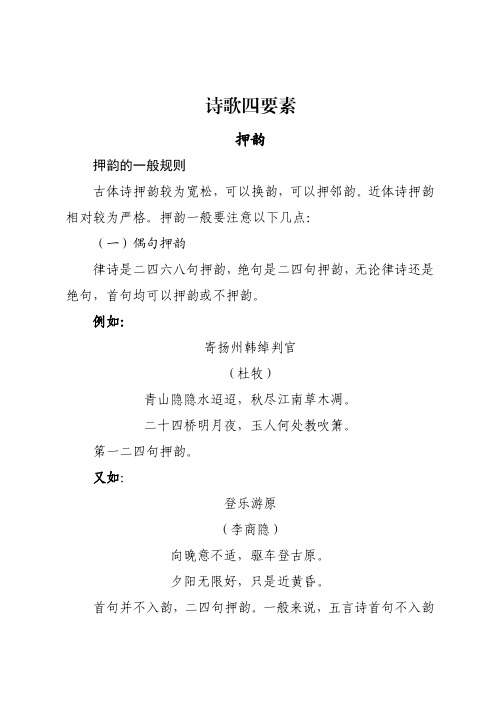
押韵押韵的一般规则古体诗押韵较为宽松,可以换韵,可以押邻韵。
近体诗押韵相对较为严格。
押韵一般要注意以下几点:(一)偶句押韵律诗是二四六八句押韵,绝句是二四句押韵,无论律诗还是绝句,首句均可以押韵或不押韵。
例如:寄扬州韩绰判官(杜牧)青山隐隐水迢迢,秋尽江南草木凋。
二十四桥明月夜,玉人何处教吹箫。
第一二四句押韵。
又如:登乐游原(李商隐)向晚意不适,驱车登古原。
夕阳无限好,只是近黄昏。
首句并不入韵,二四句押韵。
一般来说,五言诗首句不入韵为常见,七言诗首句入韵为常见。
(二)押平声韵近体诗为了声韵和谐,一般押平声韵,大多数近体诗(即唐及以后的诗,唐以前的叫古体诗)也遵守这个要求。
但仍有押仄声韵的典范之作,比如柳宗元的五言绝句《江雪》,全文押入声(短促音):千山鸟飞绝,万径人踪灭。
孤舟蓑笠翁,独钓寒江雪。
这首诗无论以古入声韵尾还是以今普通话ie、ue韵朗读,均没有拗口之嫌。
(三)一韵到底原则上,近体诗中间不能换韵,尤其是在科考考场上的试帖诗、应制诗和限韵诗。
但由于科考使用的《切韵》体系已经不完全符合唐代口语声韵,部分韵母已经合并或分离,更可能有诗人乡音难改,使用方音作诗,因而仍有在诗中更换为邻韵的作品,如杜甫的《吾宗》:吾宗老孙子,质朴古人风。
耕凿安时论,衣冠与世同。
在家常早起,忧国愿年丰。
语及君臣际,经书满腹中。
注:二、四、八句的“风”“同”“中”是平声“东”韵,第六句的“丰”是平声“冬”韵,“东”与“冬”通押。
日常作诗与应试不同,不应用应试的要求苛刻地对待作者,尤其是后世使用古韵书作诗的作者。
(四)首韵借韵古体诗的押韵,可以把邻近韵部的韵,比如一东和二冬、四支和五微,混在一起通用,称为通韵。
但是近体诗的押韵,原则上必须严格地只用同一韵部的字,即使这个韵部的字数很少(称为窄韵),也不应参杂其他韵部的字,否则叫做出韵。
但是如果是首句押韵,可以借用邻韵。
因为首句本来可押可不押,所以可以通融一下。
比如《军中醉饮寄沈八刘叟》:酒渴爱江清,余甘漱晚汀。
英文诗歌的韵律及押韵格式

英文诗歌的韵律及押韵格式一、英文诗歌的韵律(Rhythm)1. 定义与概念。
- 韵律就像是英文诗歌的心跳。
它是通过诗歌中音节的重读(stressed)和非重读(unstressed)有规律的排列而形成的。
比如说,在一个简单的单词“apple”中,“ap -”是重读部分,“ - ple”是非重读部分。
在诗歌里,这种重读和非重读音节的组合会形成一种节奏模式。
- 最常见的韵律单位叫音步(foot)。
一个音步通常包含一个重读音节和一个或多个非重读音节。
例如,“iamb”(抑扬格)这种音步,就是由一个非重读音节加上一个重读音节组成,像“be - lieve”这样的单词就可以看作是一个抑扬格音步。
2. 常见的韵律类型。
- 抑扬格(Iambic)- 这是英文诗歌里超级常见的韵律类型。
就像我们刚刚说的,它是由一个非重读音节和一个重读音节组成的音步。
像莎士比亚的十四行诗大多是用抑扬格五音步(Iambic pentameter)写的。
例如他的十四行诗第18首中的句子“Shall I compare thee to a summer's day?”(Shall I / com - pare / thee to / a sum - / mer's day?)这里每一组斜杠隔开的部分就是一个抑扬格音步,一共五个音步,所以是抑扬格五音步。
这种韵律读起来感觉很轻快,就像小步跳舞一样,有一种优雅的节奏感。
- 扬抑格(Trochaic)- 抑抑扬格(Anapestic)- 扬抑抑格(Dactylic)- 扬抑抑格是由一个重读音节和两个非重读音节组成的音步。
例如“mer - ri - ly”这个单词就是一个扬抑抑格音步。
这种韵律读起来有一种滚动感,就像小球在地上滚动一样。
在一些古老的史诗中会经常用到这种韵律,它能给诗歌增添一种宏伟、壮阔的感觉。
二、英文诗歌的押韵格式(Rhyme Scheme)1. 定义与概念。
- 押韵就是单词的最后发音相同。
- 1、下载文档前请自行甄别文档内容的完整性,平台不提供额外的编辑、内容补充、找答案等附加服务。
- 2、"仅部分预览"的文档,不可在线预览部分如存在完整性等问题,可反馈申请退款(可完整预览的文档不适用该条件!)。
- 3、如文档侵犯您的权益,请联系客服反馈,我们会尽快为您处理(人工客服工作时间:9:00-18:30)。
第一节头韵头韵是指一行(节)诗中几个词开头的辅音相同,形成押韵。
如克里斯蒂娜•罗塞蒂的《歌》前两诗节:When I am dead, my dearest,Sing no sad songs for me;Plant thou no rose at my head,Nor shady cypress tree:Be the green grass above meWith showers and dewdrops wet;And if thou wilt, remember,And if thou wilt, forget.(Christina Rossetti: Song)第一行的dead / dearest,第二行的sing / sad / songs,第五行的green / grass,第六行的with / wet押头韵。
又如柯尔律治的《古舟子咏》第103~第106行:The fair breeze blew, the white foam flew,The furrow followed free,We were the first that ever burstInto that silent sea.(Samuel Taylor Coleridge: The Rime of the Ancient Mariner)前三行里,头韵[f]重复七次。
这个摩擦送气的清辅音模仿柔风轻涛的声音,创造出一种宁静的意境。
第四行里的两个[s]音宛如和风吹过沉寂海面而发出的咝咝声。
头韵在这里的使用,令读者有身临其境之感。
另外,中间韵blew / flew,first / burst,furrow / followed,尾韵free / sea形成悦耳动听的韵味和节奏感。
再如莎士比亚编号为71的十四行诗前八行:No longer mourn for me when I am deadThan you shall hear the surly sullen bellGive warning to the world that I am fledFrom this vile world with vilest worms to dwell.Nay, if you read this line, remember notThe hand that writ it; for I love you soThat I in your sweet thoughts would be forgotIf thinking on me would make you woe.每行都有不同的头韵。
第一行为mourn / me,第二行为surly / sullen,第三行为warning / world,第四行为world / worm,第五行为read / remember,第八行为me / make和would / woe。
第二行、第三行和第五行为than / that / this,第七行和第八行为thoughts / thinking。
这样的不同首字母交替出现在一个诗节中,可以称为交叉头韵。
诗人在使用头韵时,还使用一种声音的重复,通过这种声音的重复表达一种独特的情感。
如多恩的《歌》:When thou sigh‘st, thou sigh‘st not windBut sigh‘st my soul away;When thou weep‘st, unkindly kind,My life‘s blood doth decay.It cannot be,Tha t thou lov‘st me, as thou say‘st,If in thine my life thou waste,Thou art the best of me.(John Donne: Song)此诗节使用的头韵有when / wind / weep / waste,sigh / soul / say,doth / decay,blood / be / best,thou / then / that等。
另外,在sigh、kindly、thine、my和life中有频繁的元音字母i,此音暗示悲伤和抑郁,加上它是一个长元音,自然就减缓了诗行自然的快节奏运动,哀伤和抑郁之情得到了充分的表现。
同样的诗歌技巧也体现在爱伦•坡的《乌鸦》之中,如该诗的最后一节:And the Raven, never flitting, still is sitting, still is sittingOn the pallid bust of Pallas just above my chamber door;And his eyes have all the seeming of a demon that is dreaming,And the lamp-light o‘er him streaming throws his shadow on the floor;And my soul from out that shadow that lies floating on the floorShall be lifted –nevermore!(Allan Poe: The Raven)此诗节中除了各行的头韵(still / sitting,pallid / Pallas,his / have,lamp / light,from / floating / floor),还有内韵(flitting / sitting,seeming / dreaming等),贯穿整个诗节的短元音、[æ],长元音[i:]、[o:]和双元音[əu]生动地传达出了主人公的痛苦和绝望。
第二节尾韵尾韵(end rhyme)指行尾押韵单词最后的重读元音及其后面的辅音在读音上相同,而元音前面的辅音则不能相同。
也就是说,元音以及元音后面的辅音押韵,而元音前面的辅音则不押韵。
这种韵又被称为全韵(perfect rhyme)。
根据音节的数量,可分为单音节尾韵(single rhyme)、双音节尾韵(double rhyme)和三重音节尾韵(triple rhyme)。
单音节尾韵又称男韵或阳韵(masculine rhyme),是在诗行结尾重读音节之间出现的最普遍的押韵。
如米勒《在太平洋之滨》第二诗节:Above yon gleaming skies of goldOne lone imperial peak is seen;While gathered at his feet in greenTen thousand foresters are told.And all so still! So still the airThat duty drops the web of care.(Joaquin Miller: By the Pacific Ocean)第一、四行押韵,第二、三行押韵,第五、六行押韵,都是重读单音节。
虽然是单音节押韵,但它只要求一个音节押韵,而不要求押韵的一个音节是一个单音节单词。
例如叶芝《走过柳园》第一节:Down by the sally gardens my love and I did meet;She pass‘d the sally gardens with little snow-white feet.She bid me take love easy, as the leaves grow on the tree;But I, being young and foolish, with her would not agree.(W. B. Yeats: Down by the Sally Gardens)这里第四行的agree就是一个双音节单词,它只在第二个音节上与前行的tree押韵,而且它是重读音节。
双音节韵又称女韵或阴韵(feminine rhyme),其基本特征是行尾单词最后两个音节押韵,其中倒数第二个音节是重读音节,而最后一个音节是非重读音节。
由于其读音是重读加非重读结构,因此它又称扬抑格韵(trochaic rhyme)。
如华兹华斯的《写于三月》前四行:The cock is crowing,The stream is flowing,The small birds twitter,The lake doth glitter.(William Wordsworth: Written in March at Brother‘s Water)行尾的crowing / flowing,twitter / glitter相互押韵。
两组押韵都是由双音节单词组成,每个单词的第一个音节为重读音节,第二个音节为非重读音节。
又如丁尼生《女郎夏洛特》第一部分的第二诗节:Willows whiten, aspens quiver,Little breezes dusk and shiverThrough the wave that runs foreverBy the island in the riverFlowing down to Camelot.Four grey walls, and four grey towers,Overlook a space of flowers,And the silent isle imbowersThe Lady of Shalott.(Alfred Tennyson: The Lady of Shalott, Part I)行尾的quiver / shiver / river,towers / flowers / imbowers相互押韵,除了imbowers,其余单词都是双音节单词,都是第一个音节为重读,第二个音节为非重读。
imbowers虽然是三个音节,但它的最后两个音节为重读加非重读,跟其余两个单词押韵。
这就是说,双音节韵的单词也可以是多音节单词,但其押韵的音节只能是两个,而且是多音节中最后两个音节。
同时,其结构也不能改变,是重读音节加非重读音节。
再如济慈《致一些女士》第一诗节:What though while the wonders of nature exploring,I cannot your light, mazy footsteps attend;Nor listen to accents, that almost adoring,Bless Cynthia‘s face, the enthusiast‘s friend.(John Keats: To Some Ladies)这个诗节是单韵和双韵混合使用。
